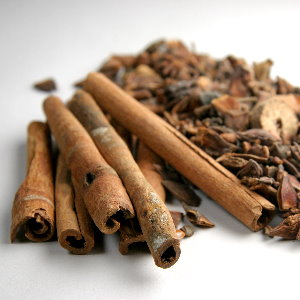Many of the amazing super smoothie recipes that we post suggest that you add a pinch of cinnamon “to taste”, but there are actually more benefits to cinnamon than just the taste! Cinnamon is a great source of manganese, fiber, iron and calcium – but what else makes cinnamon so great?
Cinnamon is a spice that has been used for centuries in cooking & baking. Cinnamon tree bark is dried and rolled into sticks or ground into powder. There are two main kinds of cinnamon, with the varieties coming from different trees. One type of cinnamon is dark brown in colour, Cinnamomum cassia, and is often used in curry powders and many asian dishes. The other type of cinnamon, Cinnamomum zeylanicum, is a lighter more tan colour.
Cinnamon has been used for centuries in Ayuvedic, Chinese & Unai medicine due to its amazing health benefits. The darker, Cassia, cinnamon is used in Chinese medicine to assist with colds, nausea, flatulence, diarrhea and to help ease painful menstrual periods. The Chinese also believe that it improves circulation, and is useful for people that suffer from cold feet & hands, with its warming effects as well as improving energy and vitality. Ayurveda uses cassia cinnamon to remedy indigestion, colds & to assist in diabetes management.
Clinical studies of Cinnamon Cassia for treatment of diabetes symptoms, when patients were consuming between 1-6 grams for a period of 40 days showed the following results:
- Fasting glucose was lowered by 18 to 29%
- LDL, or "bad" cholesterol fell on average by 7%
- Total cholesterol fell between 12-26% without any loss of the protective HDL cholesterol
- Fasting triglycerides fell 23 to 30%
-
Further studies into the benefits of cinnamon hae found that it has anti bacterial and antifungal properties. It is great for treating Candida albicans, the fungus that causes yeast infections & thrush, and Helicobacter pylori, the bacteria responsible for stomach ulcers. Further to this, it inhibits bacterial growth and food spoilage, making it a natural food preservative, particularly fighting E.coli bacteria.
Studys from Copenhagen University have shown that arthritis patients had significant relief from pain after one week of adding cinnamon with honey into their daily routine, as the cinnamon assists with circulation, making it easier for these people to move and to walk.
It is important to note, that Cinnamon Cassia contains a natural compound called coumarin. Coumarin, at high levels, can have a blood thinning effect, so it is advisable not to take in conjunction with any sort of anti-clotting medication or if you suffer from bleeding disorders. The optimal dose of cinnamon daily is about 3 grams, which is a little less than a teaspoon – so next time you are making your smoothie, chai or other sweet tea keep this in mind, you may want to add more than just a pinch!
** If you have any concerns about diabetes or cholesterol, it is advisable to see a doctor.
Warm Cinnamon Tea
4 cups water
3 slices fresh ginger, cut to the thickness of a quarter (warming, immune enhancer)
1 1-inch piece licorice root (antiviral, antibacterial, fights depression)
1 1/2-inch piece cinnamon stick (warming, digestive support, useful for diabetes)
1 tablespoon orange rind (sweet)
1 tablespoon dried parsley (digestive aid)
1 teaspoon dried lemon balm (relaxing, aromatic)
1 clove (warming, digestive aid)
In a pot, bring the water to boil, then add the ingredients and leave to infuse for 10-15 minutes. Strain & then serve.
References:
Kirkham S, Akilen R, Sharma S, Tsiami A. The potential of cinnamon to reduce blood glucose levels in patients with type 2 diabetes and insulin resistance. Diabetes Obes Metab. 2009 Dec;11(12):1100-13.
Solomon TP, Blannin AK. Changes in glucose tolerance and insulin sensitivity following 2 weeks of daily cinnamon ingestion in healthy humans. Eur J Appl Physiol. 2009 Apr;105(6):969-76. Epub 2009 Jan 22.






















